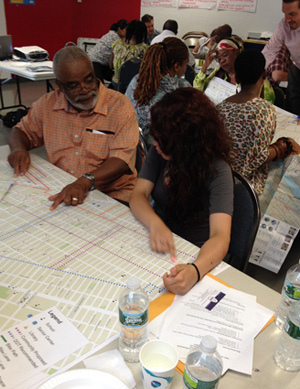After local residents and community organizations began organizing to bring bike lanes to East New York and Brownsville last year, NYC DOT is developing a plan to stripe the first bike routes directly through these neighborhoods, and more could be on the way.
The process underway in eastern Brooklyn offers an intriguing glimpse at how the city can develop neighborhood-scale bike plans -- especially promising for areas with high rates of chronic disease, where safer biking and walking can encourage more physical activity.
About 20 people gathered at the YMCA on Jamaica Avenue yesterday evening to discuss what's holding East New York residents back from biking more, and to share ideas with DOT and the Department of Health about how to improve local cycling conditions. They heard from DOT about two bike routes that are in the works and hashed out where they think more bike lanes should go.
The Department of Health is taking an active role in East New York because residents have higher-than-average incidences of chronic diseases like diabetes. According to department surveys, local residents report lower than average levels of physical activity, and DOH has identified street design as a major factor. Currently there are no bike lanes in the neighborhood, and many street crossings pose a challenge for pedestrians.
Working with local organizations like the Brownsville Partnership, the Cypress Hills Local Development Corporation, and the Pitkin Avenue BID, DOH and DOT put on a group ride around the neighborhood last October and distributed surveys to find out how local residents want to improve local biking conditions.
As a result of those surveys, DOT identified two routes to serve as the backbone of the neighborhood bike network: a north-south route on Mother Gaston Boulevard and an east-west route on Pitkin Avenue. Both would consist of painted bike lanes between the parking lane and traffic lane where the streets are sufficiently wide, and sharrows where the streets are narrower. DOT has also mapped out locations for bike racks, which are currently very scarce in the neighborhood. The tentative plan is to show the bike routes to Community Board 16 this fall in preparation for spring 2013 implementation.
That could be the first phase of a three-year plan to fill in neighborhood streets with several more options for safer cycling. The goal, said DOT, is to create neighborhood-scale bike networks that connect to the citywide network. Most of yesterday's workshop was devoted to refining the preliminary ideas for the neighborhood bike network.
After reviewing a map of several bike routes recommended through earlier surveys, participants focused on the need to create good connections between East New York and Brownsville and other neighborhoods. They asked for safe routes to Highland Park, on the north side of the neighborhood; to the Eastern Parkway greenway on the west side; and across the heavily trafficked Linden Boulevard to the south. They also asked for bike racks at every school in the neighborhood.
The discussion wasn't all about infrastructure. Police harassment also came up as an obstacle that needs to be addressed. Cleveland Smillie, who runs Brownsville Bikes on Mother Gaston Boulevard, said he often sees police cite teenagers for sidewalk riding when they are doing little more than disembarking from the curb. "[The police] stand a block away from my store," he said. "Everyone who rides on the sidewalk for two or three feet will get ticketed."
If the young people apprehended don't have identification -- and many of them don't, Smillie said -- they have to spend the night in a cell at central booking in Downtown Brooklyn. "It discourages a lot of people who want to ride," he said. The partner organizations working to improve bike conditions said the local Precinct Community Council has supported their efforts and could be an effective liaison to get police to stop harassing young people on bikes.






